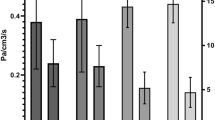Abstract
Objectives
To assess the possible relationship between various predictive factors (patient or surgery related) and the development of nasal septal perforations (NSP) with the help of a large study group.
Methods
One hundred and forty-three patients were included in the study. The presence of the following factors was evaluated and compared between the NSP and healthy group: types of surgeries, presence of unilateral or bilateral mucosal tears, concomitant inferior turbinate interventions, smoking, accompanying diabetes mellitus (DM) or allergic rhinitis (AR), types of nasal packings, duration of the surgery (minutes), and the experience of the surgeon (senior/junior). Nasal septal deviations were grouped into two: simple cartilage crests at the septum base and other—more complicated—deviations.
Results
NSP was detected in six (4.2%) patients after a mean follow-up of 9.3 ± 3.7 (min: 6 max: 14) months. None of these patients suffered from (AR) or DM. Four of these patients had unilateral and one patient had bilateral mucosal tears during the surgeries. None of the above-mentioned factors—including mucosal tears, type of the deviation or experience of the surgeon—had a significant effect on NSP.
Conclusion
Untreated bilateral corresponding mucosal tears are the main cause of NSP. When immediately repaired, unilateral or bilateral tears do not affect the development of NSP significantly. Patient-related factors such as age, DM, smoking, AR, and procedure-related factors such as duration, the complexity of the septal deviation, type of the nasal packing, and experience of the surgeon also do not have a significant effect on NSP.
Similar content being viewed by others
References
Bloom JD, Kaplan SE, Bleier BS, Goldstein SA (2009) Septoplasty complications: avoidance and management. Otolaryngol Clin North Am 42:463–481
Kridel RWH (2004) Considerations in the etiology, treatment, and repair of septal perforations. Facial Plast Surg Clin North Am 12:435–450
Kim DW, Egan KK, O’Grady K, Toriumi DM (2005) Biomechanical strength of human nasal septal lining: comparison of the constituent layers. Laryngoscope 115:1451–1453
Belmont JR (1985) An approach to large nasoseptal perforations and attendant deformity. Arch Otolaryngol 111:450–455
André RF, Lohuis PJFM, Vuyk HD (2006) Nasal septum perforation repair using differently designed, bilateral intranasal flaps, with nonopposing suture lines. J Plast Reconstr Aesthetic Surg 59:829–834
Friedman M, Ibrahim H, Ramakrishnan V (2003) Inferior turbinate flap for repair of nasal septal perforation. Laryngoscope 113:1425–1428
Kim SW, Rhee CS (2012) Nasal septal perforation repair: predictive factors and systematic review of the literature. Curr Opin Otolaryngol Head Neck Surg 20:58–65
Moon IJ, Kim SW, Han DH et al (2011) Predictive factors for the outcome of nasal septal perforation repair. Auris Nasus Larynx 38:52–57
Bousquet J, Khaltaev N, Cruz AA et al (2008) Allergic rhinitis and its impact on asthma (ARIA) 2008 update (in collaboration with the World Health Organization, GA(2)LEN and AllerGen). Allergy 63:8–160
Dąbrowska-Bień J, Skarżyński PH, Gwizdalska I, Łazęcka K, Skarżyński H (2018) Complications in septoplasty based on a large group of 5639 patients. Eur Arch Otorhinolaryngol 275:1789–1794
Lanier B, Kai G, Marple B, Wall GM (2007) Pathophysiology and progression of nasal septal perforation. Ann Allergy Asthma Immunol 99:473–480
Rettinger G, Kirsche H (2006) Complications in septoplasty. Facial Plast Surg 22:289–297
Topal O, Celik SB, Erbek S, Erbek SS (2011) Risk of nasal septal perforation following septoplasty in patients with allergic rhinitis. Eur Arch Otorhinolaryngol 268:231–233
Cetiner H, Cavusoglu I, Duzer S (2017) The effect of smoking on perforation development and healing after septoplasty. Am J Rhinol Allergy 31:63–65
Elwany S, Ibrahim AA, Mandour Z, Talaat I (2012) Effect of passive smoking on the ultrastructure of the nasal mucosa in children. Laryngoscope 122:965–969
Luan CW, Tsai MS, Liu CY et al (2020) Increased risk of nasal septal abscess after septoplasty in patients with type 2 diabetes mellitus. Laryngoscope. https://doi.org/10.1002/lary.29336
Funding
The research received no specific grant from any funding agency in the public, commercial, or not-for-profit sectors.
Author information
Authors and Affiliations
Corresponding author
Ethics declarations
Conflict of interest
The authors report no conflicts of interest. The authors alone are responsible for the content and writing of the paper.
Additional information
Publisher's Note
Springer Nature remains neutral with regard to jurisdictional claims in published maps and institutional affiliations.
Rights and permissions
About this article
Cite this article
Eren, E., Balcı, M.K. & İşlek, A. Analysis of patient- and procedure-related risk factors for nasal septal perforations following septoplasty. Eur Arch Otorhinolaryngol 279, 1357–1361 (2022). https://doi.org/10.1007/s00405-021-06887-2
Received:
Accepted:
Published:
Issue Date:
DOI: https://doi.org/10.1007/s00405-021-06887-2




